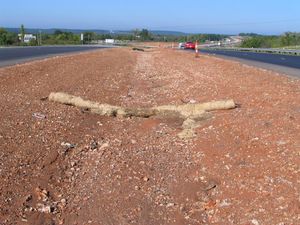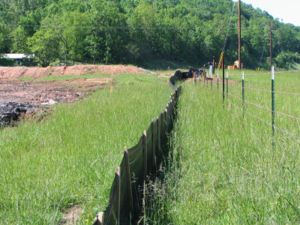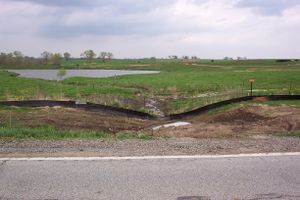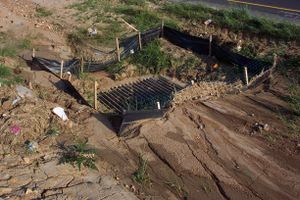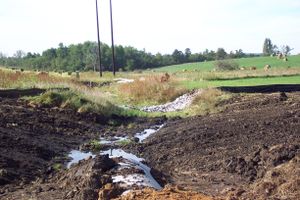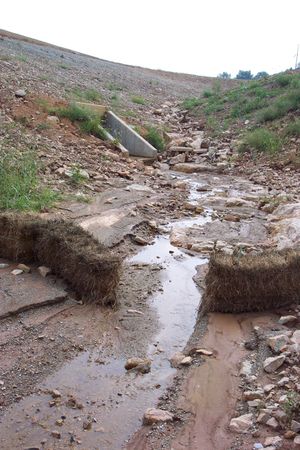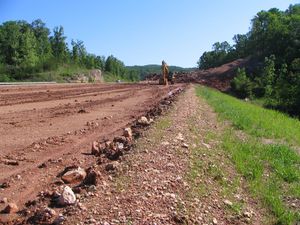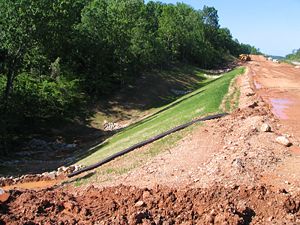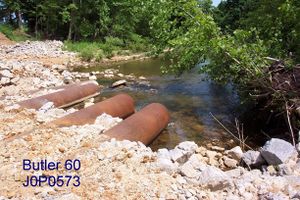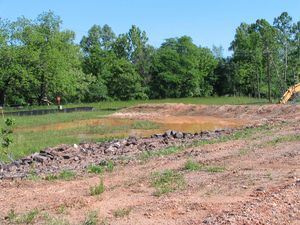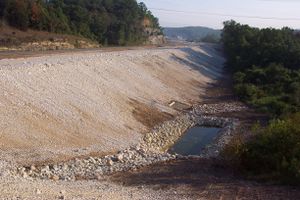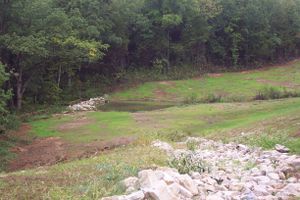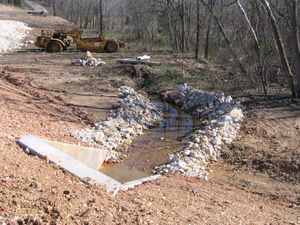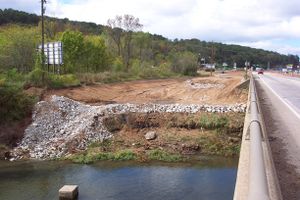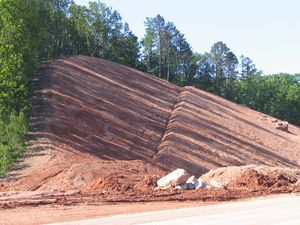Category:806 Pollution, Erosion and Sediment Control
| Key Points |
Contents
- 1 806.1 Introduction
- 1.1 806.1.1 Roadway Design Activities
- 1.2 806.1.2 Construction Activities
- 1.3 806.1.3 Maintenance Activities
- 1.4 806.1.4 Traffic Activities (Permits)
- 1.5 806.1.5 Materials Activities
806.1 Introduction
Provisions of the federal clean water act and related state rules and regulations require stormwater permits where construction activities disturb greater than one acre over the life of a project as part of a common plan or sale. MoDOT has a general permit, obtained from the Missouri Department of Natural Resources (MDNR), which allows MoDOT to accomplish road construction activities. This permit may be found at (http://www.dnr.mo.gov/env/wpp/permits/issued/R100000.pdf ). The permit stipulates that MoDOT will follow certain erosion control guidelines and install temporary erosion control measures. This permit applies only to land disturbance activities associated with MoDOT on MoDOT right of way. Locally sponsored federal aid projects will need to obtain similar appropriate permits.
806.1.1 Roadway Design Activities
Contract plans shall include erosion control measures that are sufficient to protect streams, lakes and private land adjacent to MoDOT right of way.
Temporary and permanent water pollution control measures shall be included in design plans such that contractors can develop appropriate bids. Control of water pollution will be accomplished through the use of berms, slope drains, ditch checks, sediment basins, seeding and mulching, straw bales, silt fences, and other erosion control devices or methods.
806.1.1.1 Temporary Measures
Temporary erosion control measures shall be coordinated with permanent erosion control measures to assure economical, effective and continuous erosion control.
Ditch Checks
There are two types of ditch checks that can be used – Type I and Type II. Type I ditch checks include, but not limited to, silt fence, straw bale, wattle logs, and Dura Check Sediment Control Panel®. Type II ditch checks include, but are not limited to, rock, sand bag, and Triangular Silt Dike® (see Section 806.10 of the Missouri Standard Specification For Highway Construction).
Type I ditch checks are specified where drainage areas are 3 acres or less, ditch slopes are 10 percent or less and expected ditch flow volumes are small. Type II ditch checks are specified where drainage areas are 50 acres or less, ditch slopes are 10 percent or less and expected ditch flow volumes are high, or in locations where the project is in close proximity to streams or other sensitive areas. For scenarios that exceed the criteria established above, a combination of Type II ditch checks and erosion control blankets are utilized.
Experience and history have shown that Type II ditch checks perform much better than Type I ditch checks and seldom need to be replaced. For this reason a system of Type II ditch checks, although more expensive than Type I at installation, will often prove to be the less expensive over the life of the project considering the cost of unpredictable storm damage to Type I devices.
Silt Fence
Use of a silt fence consists of furnishing, installing, maintaining, and removing a geotextile barrier fence designed to remove suspended particles from water passing through the fence. Materials used for silt fences must meet certain requirements.
Silt fencing is most effective to control sheet erosion along the edge of the right of way where runoff from erodible fill attempts to leave the project onto the adjacent property or into an adjacent stream. Silt fence is never used to cross a ditch, stream or drainage channel, and in no case installed perpendicular to, or downgrade from a pipe or culvert. Likewise, silt fence is never used to protect drop inlets. When drainages are encountered, a perimeter silt fence must be replaced or bolstered by a rock ditch check in the drainage channel.
Straw Bales
Bales of straw can be used as a means of controlling pollution and erosion. The straw bales obstruct the flow of water allowing deposition of sediment and/or diversion of water. Other foliage may be substituted for straw in accordance with Section 802.2.1 of the Missouri Standard Specification For Highway Construction.
This method is typically used at the bottom of embankment slopes to divert runoff from sheet flow and trap sediment, as a ditch check in small ditches and drainage areas, and on the lower side of the cleared areas to catch sediment from sheet flow. When used to trap sediment or divert runoff, the bales must be braced from behind. When used as a ditch check, embedment is required. Straw bales are most effective in areas where there is overland flow (runoff that flows over the surface of the ground as a thin, even layer). They are not effective in areas where there is a large volume of runoff.
Temporary Berms
A temporary berm is a temporary ridge of compacted soil, with or without a shallow ditch, constructed at the top of fill slopes or transverse to centerline on fills. The purpose of these ridges is to divert storm runoff from small areas away from steep slopes and direct this water to temporary outlets where the water can be discharged with minimum slope erosion. These ridges are used temporarily at the top of newly constructed slopes to prevent excessive erosion until permanent controls are installed and/or slopes are stabilized. They are also used transverse to grade to divert runoff to stabilized slope drains. Since temporary berms are usually installed as earth work is underway, and there is no way to predict the amount of work that might be accomplished during the course of a days work, temporary berms will not usually appear on contract plans.
Temporary Slope Drains
A temporary slope drain is used to carry water down slopes to reduce erosion and
consists of stone, concrete or asphalt gutters, half-round pipe, metal pipe, plastic pipe, or flexible rubber pipe. Temporary slope drains are required on fill slopes at approximately 500-foot intervals or as directed by the engineer.
Temporary Seeding and Mulching
This work shall consist of preparing and fertilizing a seedbed, furnishing and sowing of seed, and mulching. The purpose of temporary seeding and mulching is to produce a quick ground cover to reduce erosion in disturbed areas that are expected to be redisturbed at a later date. If the project is to be done in stages and it is known that areas will be shut down for a significant amount of time, designers are to include this cost such that contractors can bid accordingly. MoDOT does not pay for temporary seed or mulch that is used to establish ground cover that is solely established to allow the contractor to disturb additional ground beyond those restrictions in Section 806.50 of the Missouri Standard Specification For Highway Construction.
Temporary Pipe
A temporary pipe is a conduit used temporarily to carry water under a haul road, silt fence, etc. It is used to convey normal and expected high flows at temporary stream crossings, preventing the contractor's equipment from coming in direct contact with the water when crossing active streams or intermittent streams created during heavy rainfalls. All temporary pipe shall be installed in the same manner as permanent pipe is installed on the project to assure that the water does not cause erosion around the pipe. Material to backfill the pipe is placed in six-inch lifts and mechanically compacted, although a compaction test is not required.
Temporary Sediment Basin
A temporary sediment basin is an excavated or dammed storage area that is used for
short-term erosion control purposes. These structures will be constructed by available equipment as grading is underway and will not usually be shown on the contract plans. They are commonly used prior to the installation of more permanent, designed erosion controls.
Road Closure
The temporary closing of a road is not necessarily an erosion control practice; however, the total elimination of local vehicular traffic driving through bridge replacement project provides the maximum availability of all Best Management Practices (BMPs) for erosion control. Closing the road reduces the amount of land disturbance and oftentimes will result in a total disturbed area of less than one acre, the threshold that triggers the mandatory installation of erosion controls regardless of threats to water quality. Road closure usually negates the need for a temporary bypass. Design teams should consider the benefits that result from this BMP flexibility, as well as reduced land disturbance, when road closure is evaluated in the early project stages.
806.1.1.2 Permanent Measures
Sediment Basins
A sediment basin is a water storage area with rock riprap placed in inlet and outlet areas with defined side slopes
. Sediment basins are constructed to trap and store sediment from erodible areas in order to protect properties and stream channels below the installation from excessive siltation. These structures trap and store sediment that may not be caught by upgrade temporary erosion control measures. If right of way is available, a well-placed sediment basin can negate the need for other temporary controls in the drainage area upgrade from the sediment basin.
Rock Dams
A rock dam is an oversized Type II rock ditch check that serves to impound water and sediment.
It is usually is installed down grade from a culvert outlet or at locations where drainages exit MoDOT right of way. The size (length and height) of the rock dam depends on the volume of water that flows through the drainage structure, and the width of the drainage channel. Rock dams are not appropriate where impounded sediment and gravel could accumulate inside of the culvert. Also, rock dams are not appropriate in streams that are regulated by the US Army Corps of Engineers
under Section 404 of the Clean Water Act. In these cases, rock dams are to be placed at the ditch outlets, parallel to the stream . As with sediment basins, if right of way is available, a well-placed rock dam can negate the need for other temporary controls in the drainage area upgrade from the structure.
Type C Berms
Type C berms are specified at the toes of spill slopes around bridge construction operations and will be constructed to the specified dimension. It is important that the contract plans show the general presence of a type C berm so contractors may bid accordingly. However, the actual precise location of the structure can only be determined at the time of installation and shall be field fit at the direction of the engineer.
Permanent Diversions
On large, steep back slopes permanent diversion berms or terraces are used
transverse to grade to divert runoff to stabilized slope drains. Such diversions will enable the establishment of permanent vegetative cover and will reduce the likelihood of gully formation.
806.1.2 Construction Activities
806.1.2.1 Temporary Measures
Temporary erosion control measures shall be coordinated with permanent erosion control measures to assure economical, effective and continuous erosion control. Temporary erosion controls must be kept in place and maintained until revegetation has occurred to an extent sufficient to prohibit the formation of gullies by runoff. The engineer shall routinely inspect the condition of erosion controls and shall notify the contractor immediately if any controls are found to be in disrepair or are not functioning at the desired level of effectiveness. Inspection records and directives to the contractor shall be noted in the inspector's diary, which shall be available for review by MDNR upon request.
Ditch Checks
Type I and II ditch checks shall be placed and constructed according to the contract plans. They shall be checked for sediment accumulation after each significant rainfall. Sediment shall be removed when it reaches one-half of the original height of the check or sooner. Sediment removal will include removal and disposition in a location where it will not erode into construction areas or watercourses. Regular inspections shall be made to ensure that the center of the check is lower than the edges. Erosion caused by high flows around the edges of the ditch check shall be corrected immediately.
Silt Fence
There are several construction requirements for silt fences. Fence construction shall be adequate to handle the stress from hydraulic and sediment loading. Geotextile at the bottom of the fence shall be buried. The trench shall be backfilled and the soil compacted over the geotextile. The geotextile shall be spliced together as indicated on the standard drawings (see Standard Plan 806.10).
Post spacing shall not exceed 8 feet for wire support fence installations or 5 feet for self-supported installations. Posts shall be driven a minimum of 24 inches into the ground. Where rock is encountered, posts shall be installed in a manner approved by the engineer. Closer spacing, greater embedment depth and/or wider posts shall be used as necessary in low areas and soft or swampy ground to ensure adequate resistance to applied loads.
When support fence is used, the mesh shall be fastened securely to the up-slope side of the post. The mesh shall extend into the trench a minimum of 2 inches and extend a maximum of 36 inches above the original ground surface. When self-supported fence is used, the geotextile shall be securely fastened to fence posts.
The integrity of silt fences must be maintained for as long as they are necessary to contain sediment runoff. All silt fences shall be inspected immediately after each rainfall and at least daily during prolonged rainfall. Any deficiencies shall be immediately corrected. In addition, a daily review of the location of silt fences is made in areas where construction activities have changed the natural contour and drainage runoff to ensure that the silt fences are properly located for effectiveness. Where deficiencies exist, additional silt fences shall be installed as approved or directed by the engineer.
Sediment deposits shall be removed and disposed of when the deposit approaches one-half the height of the fence or sooner. If required by heavy sediment loading, a second silt fence shall be installed as directed by the engineer.
The silt fence shall remain in place until the engineer directs that it be removed. Upon removal, the contractor shall remove and dispose of any excess silt accumulations, grade and dress the area to the satisfaction of the engineer, and establish vegetation on all bare areas.
At the time of installation silt fencing is installed in permanent grass, outside of the clearing limits so that a buffer of undisturbed soil remains on both sides of the fence. Perimeter silt fence is not installed across a drainage ditch, stream or water channel.
Straw Bales
The integrity of straw bales must be maintained for as long as they are necessary to contain sediment runoff. All straw bales shall be inspected immediately after each rainfall and at least daily during prolonged rainfall. Any deficiencies shall be immediately corrected. In addition, a daily review of the location of straw bales is made in areas where construction activities have changed the natural contour and drainage runoff to ensure that the straw bales are properly located for effectiveness. Where deficiencies exist, additional straw bales shall be installed as approved or directed by the engineer.
Sediment deposits shall be removed and disposed of when the deposit approaches one-half the height of the bale or sooner. If required by heavy sediment loading, a second set of straw bales shall be installed as directed by the engineer.
The straw bales shall remain in place until the engineer directs that they be removed. Upon removal, the contractor shall remove and dispose of any excess silt accumulations, grade and dress the area to the satisfaction of the engineer, and establish vegetation on all bare areas.
Temporary Berms
Type A Berms are specified for use at the end of each day’s operations on embankments, will be constructed to specified dimensions (see Standard Plan 806.10) and will be machine compacted with a minimum of one pass over the entire width of the berm with a dozer tread, grader wheel, etc.
Type B Berms are specified when embankment operations are shut down over extended periods of time (i.e., winter), will be constructed to specified dimensions (see Standard Plan 806.10) and will be machine compacted with a minimum of three passes over the entire width of the berm with a dozer tread, grader wheel, etc. Temporary Type B berms must drain to a compacted outlet at a slope drain. The top width of these berms may be wider and the side slopes flatter on transverse berms to allow equipment to pass over these berms with minimal disruption.
Temporary Slope Drains
All temporary slope drains will be adequately anchored to the slope to prevent disruption by the force of the water flowing in these drains. The inlet end will be properly constructed to channel water into the temporary drain. The outlet ends will have some means of dissipating the energy of the water to reduce erosion downstream. Unless otherwise specified, all temporary slope drains will be removed when no longer necessary and the site will be restored to match the surroundings.
Temporary Seeding and Mulching
Seeding and/or mulching will be a continuous operation on all cut and fill slopes, waste sites, and borrow pits during the construction process. All disturbed areas shall be seeded and mulched when and where necessary to eliminate erosion. Seeding and/or mulching shall be done as soon as possible after completion of the earthwork, not to exceed 14 days, weather permitting.
Temporary mulch placed over temporary seed mixtures shall be applied in accordance with the provisions of Section 802.2.1 of the Missouri Standard Specifications For Highway Construction. Fertilizer shall be applied at the rate specified for permanent seeding. Lime will usually not be required for temporary seeding but will be applied according to governing specifications when a permanent seed mixture is used.
Permanent seeding and mulching following the temporary seeding will be performed according to Sections 805 and 802, respectively of the Missouri Standard Specification For Highway Construction and will only be permitted during the favorable seeding seasons.
Temporary Pipe
A temporary pipe is a conduit used temporarily to carry water under a haul road, silt fence, etc. It is used to convey normal and expected high flows at temporary stream crossings, preventing the contractor's equipment from coming in direct contact with the water when crossing active streams or intermittent streams created during heavy rainfalls. All temporary pipe shall be installed in the same manner as permanent pipe is installed on the project to assure that the water does not cause erosion around the pipe. Material to backfill the pipe is placed in six-inch lifts and mechanically compacted, although a compaction test is not required.
Additional Temporary Erosion Controls
- Surface Roughening
Surface roughening is a temporary erosion control best management practice that is intended to aid in the establishment of vegetative cover with seed, to reduce runoff velocity and increase infiltration, and to reduce erosion and provide for sediment trapping. This practice is intended for areas which have been cleared and grubbed and are awaiting application of temporary or permanent seed, or installation of other structural controls such as ditch checks, rock dams, or sediment basins. The practice is not intended to serve as a stand-alone best management practice and is only to be used as a short-term (2-3 weeks), sequential practice as the grading and seeding proceeds.
- Mulching and Crimping
Application of mulch without seed may be used as a temporary best management practice if approved by the engineer. This practice is most applicable in late fall or early winter when grass seed would have little or no opportunity to germinate. Straw mulch is applied with a mulch blower or by hand and must be anchored (crimped) immediately after spreading to prevent wind blow. Application rates will vary based on the percent slope.
- Brush Piles
Brush piles are considered to be a temporary BMP that is effective during clearing and grubbing operations. Tree tops, limbs, stumps and other vegetation, when placed in a drainage swale, can effectively impound gravel, soil and other eroded materials that otherwise may be carried off of MoDOT right of way during runoff periods. To be effective, brush piles are usually compressed by clearing equipment at the time of installation. Like other BMPs, brush piles are inspected following heavy rains to insure that they are functioning as intended. If the brush pile is intended to serve as a semi-permanent structure for an extended period of time beyond the clearing and grubbing stage, clean out and maintenance equivalent to that required for Type 1 and Type 2 ditch checks is required.
806.1.2.2 Permanent Measures
Construction of permanent erosion control measures that may contribute to the control of siltation, shall be accomplished at the earliest practicable time. This work shall consist of furnishing, installing, maintaining, and removing temporary control measures as shown on the plans or as ordered by the engineer. Berms, slope drains, ditch checks, sediment basins, seeding and mulching, straw bales, silt fences, and other erosion control devices or methods shall be installed so as to insure that erosion does not move soil particles off of MoDOT right of way. No work shall be started until the erosion control timetable and methods of operation have been approved.
Rock Dams
A rock dam is an oversized Type II rock ditch check that is installed down grade from a culvert outlet. The size (length and height) of the rock dam depends on the volume of water that flows through the drainage structure, and the width of the drainage channel. Rock dams are not appropriate where impounded sediment and gravel could accumulate inside of the culvert. Also, rock dams are not appropriate in streams that are regulated by the US Army Corps of Engineers under Section 404 of the Clean Water Act.
Sediment Basin
The area where a sediment basin is to be constructed shall be cleared of vegetation to enable removal of sediment. The inlets of these sediment basins shall be constructed with a wide cross section and minimum grade to prevent turbulence and allow deposition of the soil particles. When the depth of sediment reaches 1/3 of the depth of the structure in any part of the pool, all accumulation shall be removed. Discharges from the basin shall not cause scouring of the receiving area.
Sediment basins shall normally remain in service until all disturbed areas draining into the structure have been satisfactorily stabilized. When use of temporary sediment basins is to be discontinued, all excavations are to be backfilled and properly compacted, fill material removed, and the existing ground restored to its natural or intended condition.
Removed accumulated sediment and excavated material removed during construction of the sediment basin shall be disposed of in locations where sediment will not again erode into the construction areas or into natural waterways.
Type C Berm
Type C berms are specified at the toes of spill slopes around bridge construction operations and will be constructed to the specified dimension (see Standard Plan 806.10). While contract plans may show the general location of the type C berm, the precise location of the structure can only be determined at the time of installation and shall be field fit at the direction of the engineer to provide maximum stream protection, yet enable the installation of piers, bents and accommodate movement of equipment.
806.1.2.3 Site Inspections and BMP Repair
Site Inspection Reports
MoDOT shall ensure the land disturbance site is inspected on a regular schedule and within a reasonable time period (not to exceed 72 hours) following heavy rains. Regularly scheduled inspections shall be at a minimum once per week. For disturbed areas that have not been finally stabilized, all installed BMPs and other pollution control measures shall be inspected for proper installation, operation and maintenance.
Locations where storm water leaves the site shall be inspected for evidence of erosion or sediment deposition. Any deficiencies noted during a weekly inspection shall be corrected within seven calendar days of that inspection. The results of the weekly inspections in a given month shall be recorded in that month’s report. The Engineer shall promptly notify the site contractors responsible for operation and maintenance of BMPs of the deficiencies.
A log of each inspection shall be kept . The inspection report is to include the following minimum information: inspector’s name, date of inspection, observations relative to the effectiveness of the BMPs, actions taken or necessary to correct deficiencies, and listing of areas where land disturbance operations have permanently or temporarily stopped. The inspection report shall be signed by the Engineer or by the person performing the inspection if duly authorized to do so.
Proper Operation and Maintenance
The Engineer shall at all times maintain all pollution control measures and systems in good order to achieve compliance with the terms of this general permit. The need to halt or reduce the construction activity in order to maintain compliance with general permit conditions shall not be a defense to MoDOT in a regulatory agency enforcement action.
General Environmental Protection
MoDOT personnel or contractors hired by MoDOT shall comply with these and any other federal, state, and local laws and regulations controlling pollution of the environment. To ensure that these general criteria are met, the following guidelines will be observed:
- Machinery shall be kept out of the waterway as much as possible.
- Fuel, lubricants, debris and other water contaminants shall not be stored in areas that are subject to contact with water (e.g. adjacent to stream banks) or where contaminated runoff from the storage areas can enter waters.
- Refueling and maintenance (e.g., oil changing) of machinery shall not take place in, or directly alongside, any water body.
- Clearing of vegetation/trees shall be kept to the minimum required to accomplish the activity.
- Riparian areas and banks shall be restored to a stable condition through recontouring and revegetation of the area, as necessary, as soon as possible (normally within three working days of final contouring).
- Work shall be conducted during low flow whenever possible.
- Wetland areas shall be avoided to the extent practical.
- Work shall conform to all conditions that are part of the 401 and 404 permit.
806.1.3 Maintenance Activities
Maintenance activities that involve land disturbance (destruction of the root zone) of greater than 1 acre can be accomplished under the provisions of MoDOT’s land disturbance permit that has been issued by MDNR. In such cases the same erosion controls that are used during roadside development can be used to effectively reduce the off site movement of soil particles.
Regardless of the size of the land disturbance operation, precautions must be taken to insure that erosion and sediment delivery off of MoDOT’s right of way does not occur.
In cases where a construction job has been completed and the contractor has left the site and not removed Type 1 erosion controls, it shall be the responsibility of Maintenance to remove and or maintain the erosion controls. Old ditch checks that remain in the medians or ditches can create gully erosion as they eventually degrade and fall apart. Once permanent vegetation has been established and mowing has commenced, Type 1 structures should be removed. Rock ditch checks may remain in place indefinitely as long as safety (clear zone) issues are absent.
From an erosion control standpoint removal of trees, brush and grass by grubbing or mowing, for aesthetic purposes, is inadvisable.
806.1.4 Traffic Activities (Permits)
MoDOT is the holder of a State Operating Permit (issued under the provisions of the National Pollutant Discharge Elimination System - NPDES) for work that is performed on MoDOT R/W by MoDOT or its contractors. However, MoDOT’s permit does not authorize work by private developers or other public or private entities that perform limited work on MoDOT R/W as part of a larger project.
If a non-MoDOT project will involve disturbance of 1 acre or more of ground surface, then the developer will most likely require an NPDES permit from MDNR. Before MoDOT issues an entry or access permit to perform work on MoDOT R/W, the developer must provide proof that they have obtained the appropriate permit from MDNR, or some type of proof that the activity is exempt from MDNR’s NPDES requirements.
806.1.5 Materials Activities
The District Geologist, working with the project development team will determine the steepness of the back slopes and the fill slopes based on the soils and geology of the area. Erosion and subsequent water pollution can be an issue when sediment from eroding back slopes and fill slopes is not captured in the ditch at the toe of the fill. In situations where steepness of slopes or undesirable soils and geology leads to the inability to achieve a desirable stand of permanent vegetation, permanent features on the slope, or in the ditch down grade from the fill, are to be installed.
Articles in "806 Pollution, Erosion and Sediment Control"
The following 8 pages are in this category, out of 8 total.
8
- 806.1 Erosion Control Measures
- 806.2 Sediment Control Measures
- 806.3 Additional Temporary Erosion and Sediment Controls
- 806.4 Preactivity Meeting
- 806.5 Site Inspections and BMP Repair
- 806.6 Proper Operation and Maintenance
- 806.7 Other Divisions' Activities
- 806.8 Storm Water Pollution Prevention Plan (SWPPP)


